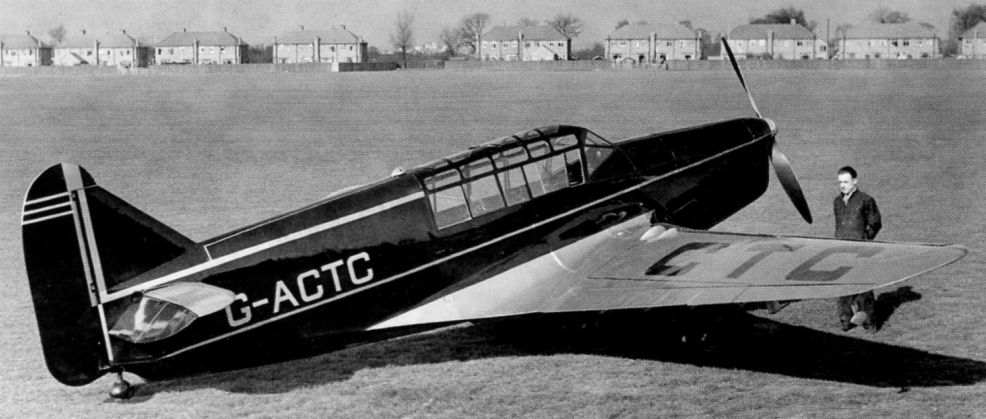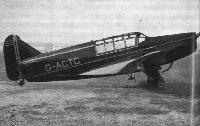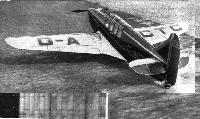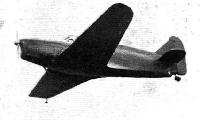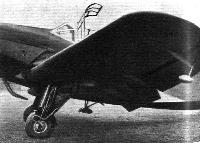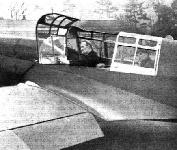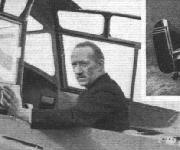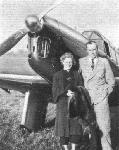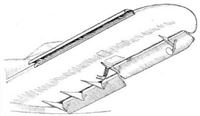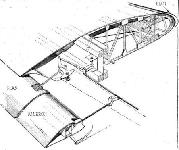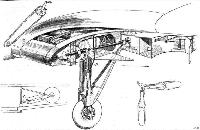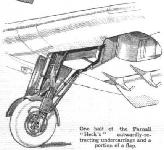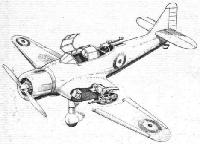Parnall Heck
В мае 1936 года компании "George Parnall & Company", "Hendy Aircraft Company" и "Nash & Thompson Ltd" объединились в компанию "Parnall Aircraft Ltd". Ее первый самолет Parnall 3308 Heck был облетан в июле 1934 года и получил известность как Hendy Heck. Конструктивно прототип, построенный компанией "Westland" в Йовиле, представлял собой двухместный моноплан с закрытой кабиной и посадкой по схеме тандем, с убирающимся шасси и двигателем de Havilland Gipsy Six мощностью 200 л. с. (149 кВт). Проблемы с шасси заставили разработчика сделать его неубирающимся, колеса были снабжены обтекателями. В итоге шесть серийных самолетов Heck 1C построили как трехместные машины с двигателем de Havilland Gipsy Queen мощностью 200 л. с. Продаж не последовало, четыре самолета использовались самой компанией для связи, а еще два проходили испытания с вооружением, прицелами пушек и воздушными винтами для Королевских ВВС Великобритании. Последний уцелевший Heck был вторым серийным самолетом, поврежденным до непригодного для ремонта состояния в июне 1950 года. Еще один самолет, вариант Parnall 382 с открытой кабиной, был построен как тренировочный самолет для начального обучения, однако серийных заказов вновь не последовало.
Показать полностьюShow all
Flight, July 1934
NEW AEROPLANES IN KING'S CUP RACE
HENDY "HECK" AND "HOBO"
Built for Mr. Whitney Straight, the "Heck" has already been given a good deal of publicity, as it is a special job for this well-known racing motorist, who wanted to have a machine which would enable him to get about between motor races, both on the Continent and in this country, in the shortest space of time. Mr. B. B. Henderson has, therefore, taken considerable trouble to ensure a very high cruising speed together with a comparatively low landing speed when designing this machine.
The "Heck" is a two-seater tandem cabin, low-wing monoplane designed with the well-known "Hendy 302" as a basis. Features which separate the "Heck" from most other machines are the use, not only of a retractable undercarriage, but also of slotted flaps and deeply filleted wing roots. The undercarriage is of the type which, by means of worm gearing operated from the pilot's cockpit, is swung outwards up into the wing, and disappears completely in the retracted position. The shock-absorbing leg, which incorporates two compression units, has been designed by Mr. Dowty, of Aircraft Components, Ltd., and, despite the small space into which the undercarriage has to be stowed, it has been possible to allow a travel of 9 in., a factor which permits better use of the slotted flaps than is generally the case. The flaps run the whole length of the trailing edge of each wing, and the outer sections are used as ailerons. When the inner sections are depressed, they are followed at a lesser angle by the outer sections, which, however, retain their full efficacy as ailerons.
<...>
Mr. Henderson has consistently got just a little more out of his machines than has generally been expected, so both the "Heck" and the "Hobo" may be counted upon as possible "dark horses" for the race. The "Heck" has been built under the direction of Mr. Henderson in the Westland Aircraft Works at Yeovil.
HENDY "HECK."
D.H. " GIPSY SIX," 200 H.P. ENGINE.
Span 31 ft. (9,4 m)
Wing area 150.2 sq. ft. (13,9 m2)
Gross weight 2,400 lb. (1 088,6 kg)
Tare weight 1,520 lb. (689,4 kg)
Wing loading 16 lb./sq. ft. (78,1 kg/m')
Power loading 11.7 lb./h.p. (5,3 kg/hp)
Показать полностьюShow all
Flight, February 1935
A FAST TWO-SEATER
The Latest Hendy "Heck": Top Speed of 170 m.p.h.: Slots and Flaps Give Noteworthy Low-speed Characteristics
ENGLISH aeroplane designers have consistently led the world in light machines. For many years they remained true to biplanes, but recently they have turned more toward the monoplane type. This tendency was, perhaps, brought about in the first place by a desire for more speed, but almost coincident with it came the demand for machines which would not only stand knooking about, but which had no wires and struts for the private owner to true-up.
The monoplane form offers a solution of many of these problems; it has thick wings which can be made very rigid so that they can be used for pushing the machine about on the ground: it facilitates the use of a retractile undercarriage, as the thick wing forms a convenient receptacle for the retracted wheels: and it was realised, when monoplanes came into general use, that the proximity of the wing to the ground produced a decided “squashing effect” when landing, attributed by some to compression of air between the wing and the ground, which gave slower and more gentle landings than with the biplane.
There are many advantages claimed for the biplane which, in some designers' eyes, make that type preferable to the monoplane, and the monoplane versus biplane controversy depends almost entirely on each designer's idiosyncrasies for its solution in each particular case, but the above are a few of the reasons why so many of our modern light aircraft are now monoplanes.
The Hendy "Heck,” of which Flight gave a preliminary description on July 12, 1934, is a two-seater tandem cabin low-wing monoplane, designed to the order of Mr. Whitney Straight (who is, perhaps, best known for his motor racing successes) by Mr Basil Henderson, of the Hendy Aircraft Co., Ltd., and built at the Westland Aircraft Works at Yeovil The machine has a "Gipsy Six" 200 h.p. engine, and with a wing loading as high as 17.5 lb./sq.ft. the speed range in the air is probably greater than has been achieved in any similar machine which has not primarily been built for competition work; that is to say the “Heck" is a rugged machine designed in every way for hard work, but it has nevertheless a performance which a few years ago, would have been credited only to machines like those built especially for the International Touring Competition and which were, in so many cases, of little use for practical work.
A top speed of about 170 m.p.h. is at present attainable but when arrangements have been made with the engine manufacturer which will allow the electric generator and the venturi tubes of the navigating instruments being placed inside, out of the slipstream, Mr. Henderson confidently expects that he will obtain several more m.p.h. This speed has been achieved by clean aerodynamic design, involving the use of the Henderson retractile undercarriage, which was described in last week's issue, and a heavily tapered wing of small area and drag.
The bottom end of the speed range is, perhaps, almost more interesting, the stalling speed being as low as 40 m.p.h., while a two-mile speed course has been flown over in each direction without loss of height at 44.8 m.p.h.
These low figures are largely attributable to the use of slotted flaps and automatic leading-edge slots of the Handley Page type. The flaps, forming the inner portion of the trailing edge of each wing, can be depressed 40 deg. from the normal, and the last part of their travel also lowers the mid position of the aileron movement by some 15 deg., so that, in effect, the whole of the trailing edge is then acting as flap surface.
A short trial in the air enhanced, if anything, the designer's claims as to stability at low speeds and retention of full control on all axes, even when fully stalled and descending at about 11 ft. per second - a figure so low that it opens up possibilities for fully stalled "parachute" landings. The outlook in the air is excellent. The ruggedness of the construction and excellent workmanship throughout give a high degree of confidence - confidence which is certainly necessary in a machine which is capable, as is the "Heck," of being dived at 260 m.p.h.
The pilot's cockpit is well laid out, although the considerable slope of the glass-covered roof necessitates a position somewhat too far away from the dashboard to satisfy all tastes; however, this in no way impairs the outlook.
It should be pointed out that at the time the photographs accompanying this article were taken the machine was only rough-painted, and had not its final colour scheme of black and gold, which has been designed by Mr. McKnight Kauffer, the well-known artist.
Показать полностьюShow all
Flight, April 1936
MODERN LIGHT AIRCRAFT REVIEW
PARNALL
DESIGNED by Mr. Basil B. Henderson, the original Heck was produced rather more than a year ago, and proved itself a very interesting aeroplane with a high top speed and a very wide speed range. This was attained by the use of leading edge slots and slotted trailing edge flaps. It may be recalled that last November Mr. David Llewellyn and Mrs. Wyndham clipped nearly 19 hours off the existing record for a flight from Capetown to England, thus proving the merits of the Heck.
After an amalgamation of interests, Parnall Aircraft, Ltd., of Yate, Glos, now have the production of the Heck in hand. The new model differs in certain minor respects from the prototype, although all the essential features have been retained. The fuselage has been lightened slightly and instead of the retractable undercarriage of the original machine the production model will have a streamlined pure cantilever undercarriage and castering self-centring tail wheel by Dowty.
The leading edge slots are automatic in action, but the trailing edge flaps are operated by the pilot. A very neat mechanism is incorporated, by which the inner flaps move down through a greater angle than that through which the aileron flaps move. The ailerons, of course, retain their differential action when moved down to increase lift. With flaps down the approach angle is quite steep, and the landing speed relatively low.
For the present, performance figures relating to the production Heck cannot be given, but it may be recalled that the prototype did rather better than 170 m.p.h. One may assume that the new type will have approximately the same speed. The landing speed of the original was in the neighbourhood of 40 m.p.h., so that the speed range exceeded 4 to 1. Over a measured course the machine was timed at an average speed of 44.8 m.p.h. without loss of height, i.e., in horizontal flight, thereby demonstrating beyond any possible doubt the effectiveness of the slots and flaps in increasing the maximum lift while still retaining full controllability at very low speeds.
Structurally the new Heck follows exactly the principles used in the prototype. Wood is the chief material, and the expert woodworkers of Parnall Aircraft, Ltd., have made a very excellent job of the machines which Flight's representatives saw in course of production at Yate a short time ago. The workmanship is excellent and the finish as good as anything to be found anywhere.
It may, perhaps, be recollected that in the original Heck the cabin was entered "over the top," via the hinged windows. The new machine has a more orthodox door.
Final details of the cabin layout of the production Heck were not available when Flight went to press with this issue, but normally the machine will seat pilot and two passengers, although it is possible that for purchasers who desire a four-seater, such accommodation may be provided.
The Heck will be available with two power plants, the Gipsy Six and the Wolseley Aries. The fittings on the corners of the engine bulkhead are arranged to take either the Gipsy or the Aries engine mountings without alteration.
Makers: Parnall Aircraft, Ltd., Yate, Glos.
Показать полностьюShow all
